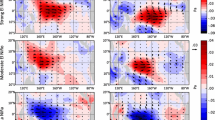Abstract.
This study explains why a number of El Nino properties (period, amplitude, structure, and propagation) have changed in a coherent manner since the late 1970s and why these changes had almost concurred with the Pacific decadal climate shift. Evidence is presented to show that from the pre-shift (1961–1975) to the post-shift (1981–1995) epoch, significant changes in the tropical Pacific are found in the surface winds and temperature, whereas changes in the thermocline are uncertain. Numerical experiments with the Cane and Zebiak model demonstrate that the decadal changes in the surface winds qualitatively reproduce the observed coherent changes in El Nino properties. The fundamental factor that altered the model's El Nino is the decadal changes of the background equatorial winds and associated upwelling. The annual cycle is also necessary for the mean state to modulate El Nino. From the pre- to post-shift epoch, the changes in the background winds and upwelling modify the structure of the coupled mode (eastward displacement of the equatorial westerly anomalies) by reallocating anomalous atmospheric heating and SST gradient along the equator. This structural change amplifies the ENSO cycle and prolongs the oscillation period by enhancing the coupled instability and delaying transitions from a warm to a cold state or vice versa. The changes in the mean currents and upwelling reduce the effect of the zonal temperature advection while enhance that of the vertical advection; thus, the prevailing westward propagation is replaced by eastward propagation or standing oscillation. Our results suggest a critical role of the atmospheric bridge that rapidly conveys the influences of extratropical decadal variations to the tropics, and the possibility that the Pacific climate shift might have affected El Nino properties in the late 1970s by changing the background tropical winds and the associated equatorial upwelling.
Similar content being viewed by others
Author information
Authors and Affiliations
Additional information
Electronic Publication
Rights and permissions
About this article
Cite this article
Wang, .B., An, .S. A mechanism for decadal changes of ENSO behavior: roles of background wind changes. Climate Dynamics 18, 475–486 (2002). https://doi.org/10.1007/s00382-001-0189-5
Received:
Accepted:
Issue Date:
DOI: https://doi.org/10.1007/s00382-001-0189-5




